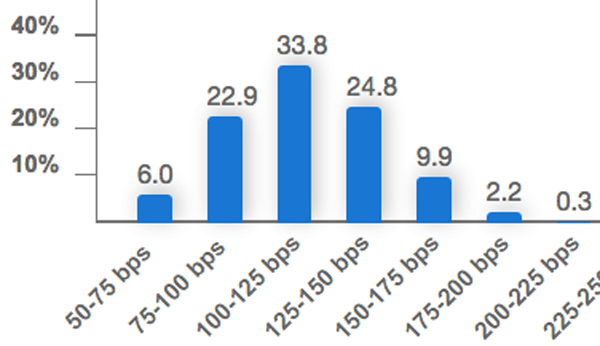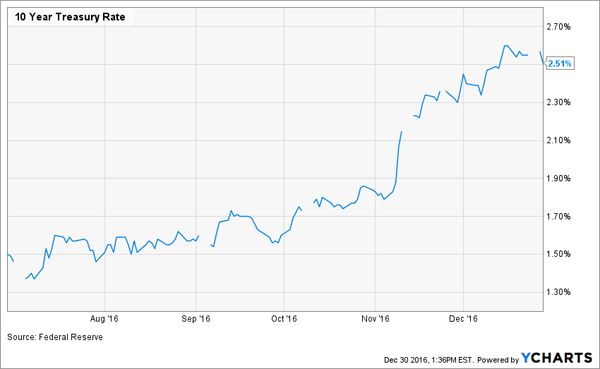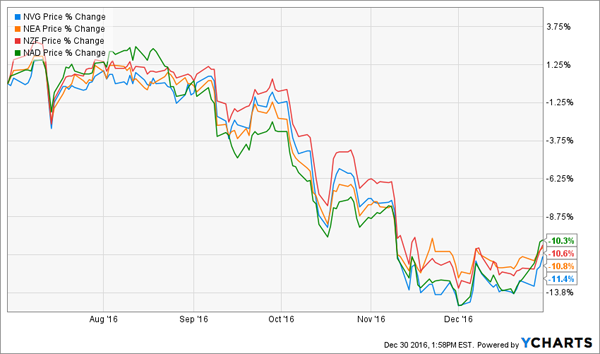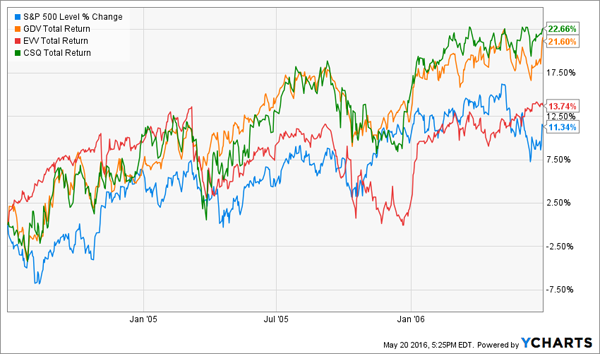What will 2017 hold for income investors?
Let’s sort through the current hysteria regarding interest rates, Trump and inflation.
[ad#Google Adsense 336×280-IA]Thanks to some first-level insanity, there are once again pockets of value that pay meaningful dividends of 6%, 7% or better.
And many have some price upside to boot! Why?
Because Rate Hikes Will Probably Disappoint
This time last year, the Fed was promising four rate hikes over the next twelve months. The “smart money” crowd (via Fed Funds futures prices) was betting on two.
And both parties were too aggressive as we saw just one rate hike in 2016.
Today we have Yellen & Co promising three hikes in 2017, while the futures markets say just two:
The Smart Money Bets 2 Hikes in 2017

Given their track records, I’m inclined to take the “under” on both predictions. But it doesn’t really matter if we see one rate hike or two (or even three) next year.
The income investments I like best have already been discounted well in excess of their rate hike risk. I’ll highlight a few in a minute – but first, let’s address the long-term rate boogeyman, too.
The Long Bond Needs a Breather
The 10-year Treasury rate has nearly doubled off its summer lows. It pays 2.5% today and, quite frankly, needs a breather:
The 10-Year Yield Won’t “Go Parabolic”

When everyone believes long-term rates have nowhere to go but up, you know what happens – they drop. Get ready for a pullback that will surprise everyone.
Best Dividend Buys Until Reality Sets In
A conservative Fed and a correction in long-term rates will send the share prices of our favorite dividends stocks and funds higher, which will compress their yields lower. Which means the best time to buy them, and maximize our current yield and upside, is right now.
Municipal (muni) bonds are great bargains today. They pay 10%+ tax equivalent yields, and certain funds have 40% upside over the next 12 months. It’s been a rough 6-months for the sector, but these four prominent funds appear to be carving out a bottom (as I forecasted last month):
Muni Funds Bounce – Hopefully You Bought!

There’s still plenty of upside in these funds. Nuveen’s AMT-Free Municipal Credit Income Fund (NVG), for example, pays a 6.1% annual distribution and trades at a 7% discount to its net asset value (NAV). This means you’re buying its holdings, which were handpicked by savvy manager Paul Brennan, for just 93 cents on the dollar.
But don’t be fooled by that “sandbagged” 6.1% yield. It’s tax-exempt at the Federal level, which means folks in the top tax bracket are actually banking a 10.1% payout.
Some first-level types worry that Trump’s tax cuts will make munis less attractive. But even if the top bracket drops to 33%, you’re still looking at a 9.1% tax-equivalent payout.
Preferred Shares: Find Floating Rates
Most investors only consider “common” shares of stock when they look for income. These are the shares in a company you receive when you place an order with your broker.
Take Wells Fargo (WFC) for example. Recent scandal aside, it’s a model big bank. Warren Buffett has held shares for 27 years and counting, slowly adding to his position over time. The firm is better run than most competitors – its efficiency ratio (costs as a percentage of revenue) is just 57.4%, compared with a sector average of 68.7%.
Problem is, everyone knows it’s a model big bank. Investors constantly bid up Wells’ common share price to capture its safe dividend, which keeps its current yield in check:
Even in Scandal, Wells Pays Less Than 3.5%

Most investors however don’t know about Wells’ preferred stock. Its “Series L” shares, for example, currently yield 6.3%, more than double the common’s payout.
In many cases, you can boost your dividends by 100% to 150% simply by trading in your common shares for the preferred variety.
However they are complicated to buy (Series what?), so you may be tempted to take a logical shortcut and purchase an ETF. After all, funds like the iShares S&P U.S. Preferred Stock Index Fund (PFF) and the PowerShares Preferred Portfolio (PGX) pay 6.7% and 6.5% respectively and provide you with one-click diversification.
Don’t take easy street. As I warned you in September, diversification in preferreds is actually not what you want. When you buy a basket of these, you are going to get enough basketcases to drag down your returns!
Plus, these ETFs don’t emphasize floating-rate securities enough. Just ten years ago, less than 10% of preferred issues were floating rate. Today, that number has jumped to more than 60%.
Your best bet? Choose a fund manager that understands credit and interest rate risk. Pick the right vehicle and you can bank an 8.1% yield thanks to a management team with decades of experience picking the right preferreds. I’ll explain the specifics of my favorite preferred fund in a minute. But first, let’s broaden our focus to find even more income bargains.
Closed-End Funds: Embrace the Rate Hike
Many other closed-end funds (CEFs) – like the muni bond funds I highlighted earlier – are selling at bargain prices today thanks to the headline worry that higher rates hurt CEFs. But that’s just not true.
Libor is tied closely to the Fed funds rate. And the last time the Fed hiked it significantly, CEFs did just fine.
In June 2004, Fed chair Alan Greenspan increased the federal funds rate from 1% to 5.25%. How’d CEFs perform? Three popular funds all outperformed the market during Greenspan’s run:
Higher Rates No Problem for Top CEFs 2004-06

Today you can build a diversified portfolio of CEFs yielding 7% or better, trading at discounts to NAV of 10% or more. Don’t be scared by the headline “rate risk” worries – take advantage of these bargains before rates correct.
But as with preferreds, choose funds that have wide mandates – so that management is able to sufficiently hedge its interest rate risk.
— Brett Owens
The 3 Best Closed-End Funds to Fund Your Retirement [sponsor]
Closed-end funds are a cornerstone of my 8% “no withdrawal” retirement strategy, which lets retirees rely entirely on dividend income and leave their principal 100% intact.
Well that’s not exactly right. Their principal is more than 100% intact thanks to price gains like these! Which means principal is actually 110% intact after year 1, and so on.
To do this, I seek out closed-end funds that:
- Pay 8% or better…
- Have well funded distributions…
- Trade at meaningful discounts to their NAV…
- And know how to make their shareholders money.
And I talk to management, because online research isn’t enough. I also track insider buying to make sure these guys have real skin in the game.
Today I like three “blue chip” closed-end funds as best income buys. And wait ‘til you see their yields! These “slam dunk” income plays pay 8.2%, 9.9% and even 10.1% dividends.
Plus, they trade at 10-15% discounts to their net asset value (NAV) today. Which means they’re perfect for your retirement portfolio because your downside risk is minimal. Even if the market takes a tumble, these top-notch funds will simply trade flat… and we’ll still collect those fat dividends!
If you’re an investor who strives to live off dividends alone, while slowly but safely increasing the value of your nest egg, these are the ideal holdings for you. Click here and I’ll explain more about my no withdrawal approach – plus I’ll share the names, tickers and buy prices of my three favorite closed-end funds for 8.2%, 9.9% and 10.1% yields.
Source: Contrarian Outlook
